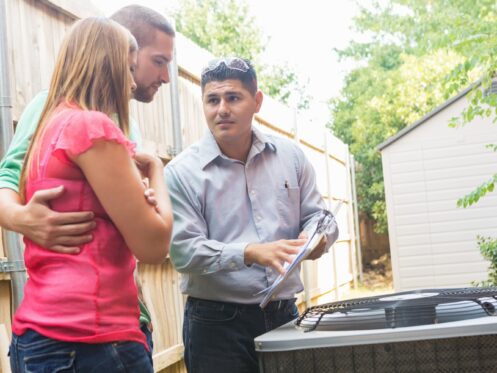Many U.S. homes have a traditional HVAC system, which pairs an air conditioner with a heating system. Heat pumps are an alternative and among the hottest trends in home HVAC. Let’s explore the advantages and disadvantages of both approaches to see which is right for you.
Traditional HVAC Systems
What’s meant by “traditional HVAC system” varies slightly depending on where in the country you live. Here, we’ll define it as pairing a cooling solution with a heating solution. The most common equipment in U.S. homes is a central air conditioner and a forced-air furnace.
Central Air Conditioner
Central air conditioners provide cooled air to a home through ductwork. The typical AC installation is a split system, which means it has outdoor and indoor equipment. The outdoor unit houses the condenser fan, pump, and coil. The indoor unit houses the air handler, evaporator coil, and condensate drainage system. Air conditioners use refrigerant to absorb heat inside the home and transfer it to the ambient air. The industry uses the seasonal energy efficiency ratio (SEER) to measure air conditioner energy efficiency over an entire cooling season. An air conditioner with a higher SEER rating will be more eco-friendly and cheaper.
Forced-Air Furnace
Over 80% of U.S. homes get their heating from a forced-air furnace. Furnaces generate heat directly and then blow it through ducts. Furnaces are generally packaged solutions with indoor equipment only. In traditional HVAC setups, they’ll often share the blower with the air conditioner. Most households have furnaces that burn natural gas, fuel oil, or liquid propane. An alternative is an electric furnace that heats the air with a coil rather than through combustion.
The industry measures furnace energy efficiency with the annual fuel utilization efficiency (AFUE) rating. A standard fuel-burning furnace usually has an AFUE around 80. That indicates it successfully converts 80% of the fuel it burns into heat that reaches the living spaces. Electric furnaces typically have an AFUE at or near 100. Fuel-burning furnaces are more common because electric furnaces are more expensive to run.
Other Heating Solutions
The most common alternatives to furnaces are hot water and steam boilers. These systems neither require ducts nor need to share the blower with the air conditioner. Instead, they deliver hot water or steam to baseboard radiators, wall radiators, or radiant floor panels. The heat from the water or steam then emanates from these fixtures.
Heat Pump
Air conditioners provide only cooling, and furnaces and boilers provide only heating. Heat pumps are different in that they provide both cooling and heating. They’re also quite similar to air conditioners in their components and use of refrigerant. A core difference is a reversing valve that allows the refrigerant cycle to flow in the other direction.
Geothermal Heat Pump
Heat pumps and air conditioners transfer heat energy from one medium to another. Geothermal systems transfer it from the indoor air to the ground or a larger body of water, and vice versa. This is why you’ll also see them called ground- and water-source heat pumps. Due to these sources, geothermal heat pumps can access abundant heat energy no matter how cold it gets. They are more expensive to purchase and install than traditional HVAC and standard heat pumps. That said, homeowners can often recoup the investment due to lower operating costs and longer equipment lifespans.
Air-Source Heat Pump
Air-source heat pumps transfer heat energy to and from the ambient air. That’s precisely what a typical central air conditioner does during the summer. What’s notable about wintertime operation, is that heat energy in the ambient air is less abundant. For this reason, many air-source heat pumps have cold-temperature thresholds at which they’re no longer as efficient. Homeowners have a couple of options. They can invest in a high-efficiency air-source heat pump that remains efficient at low enough temperatures for their climates. An alternative is hybrid heating, which the industry often calls a dual-fuel heat pump.
Hybrid Heating
A dual-fuel heat pump combines an air-source heat pump with a furnace. The heat pump meets the home’s cooling needs and generally about 85% of its heating needs. The furnace serves in an auxiliary capacity. When it’s too cold for the heat pump to be efficient, it provides the home’s heating instead. While this approach is more expensive initially due to the extra equipment, it can offer significant long-term savings.
Safety
Electric heating is safer because there’s no carbon monoxide (CO) poisoning risk. You won’t need CO detectors if you convert from traditional HVAC system to a standalone heat pump. This is also true if you opt for an electric boiler, primary, or auxiliary furnace.
Energy Efficiency
Air conditioners and heat pumps deliver the same energy efficiency for cooling. Heat pumps are generally much more efficient than furnaces and boilers for heating. Consider that even the best high-efficiency furnaces are only 98.5% efficient. On the other hand, heat pumps can deliver efficiency between 300% and 400%. A heat pump will reduce your household’s carbon footprint and heating costs. That’s why hybrid heating is often a significant investment even in the coldest U.S. climates.
Upfront & Long-Term Costs
If you upgrade from an air conditioner and furnace to a standalone air-source heat pump, your installation costs may be lower. Otherwise, most installations involving a heat pump will be more expensive than a traditional AC or furnace installation. Heat pump setups usually result in lower total costs due to lower operating costs and longer equipment lifespans. The federal government also offers a significant heat pump rebate through the states, which can also make a substantial difference.
Maintenance
The HVAC industry recommends seasonal HVAC maintenance. That includes a cooling tune-up in the spring and a heating tune-up in the fall. Your system requires at least two appointments annually even if you have a standalone heat pump. Most HVAC warranties require it. Routine maintenance promotes better air quality and helps to avoid most repairs. It can also increase efficiency, reduce operating costs, and extend equipment lifespans.
Humidity
The Environmental Protection Agency recommends maintaining a relative humidity (RH) between 30% and 60%. Air conditioners and heat pumps are similar in reaching the 60% RH target in summer. You may need a whole-house dehumidifier if your system struggles due to your climate.
Low humidity is often a byproduct of running a furnace, which is why many homes need a furnace humidifier. Heat pumps don’t produce drier air to the same degree as furnaces. You may need a whole-house humidifier if your low humidity problems are more widespread.
Heat Pump & Traditional HVAC Installation in Colorado Springs
The best way to determine which system is right for your home is through an in-person consultation with an installer. Alphalete Plumbing Drain Heating & Air is an HVAC company located in Colorado Springs, CO, and we provide free, no-obligation consultations throughout the region. We offer a wide selection of cooling, heating, and ventilation products from the top-rated brands. We also have NATE-certified technicians who install all HVAC brands and models.
To learn more about our products and your cooling and heating installation options, call today or contact us online.


